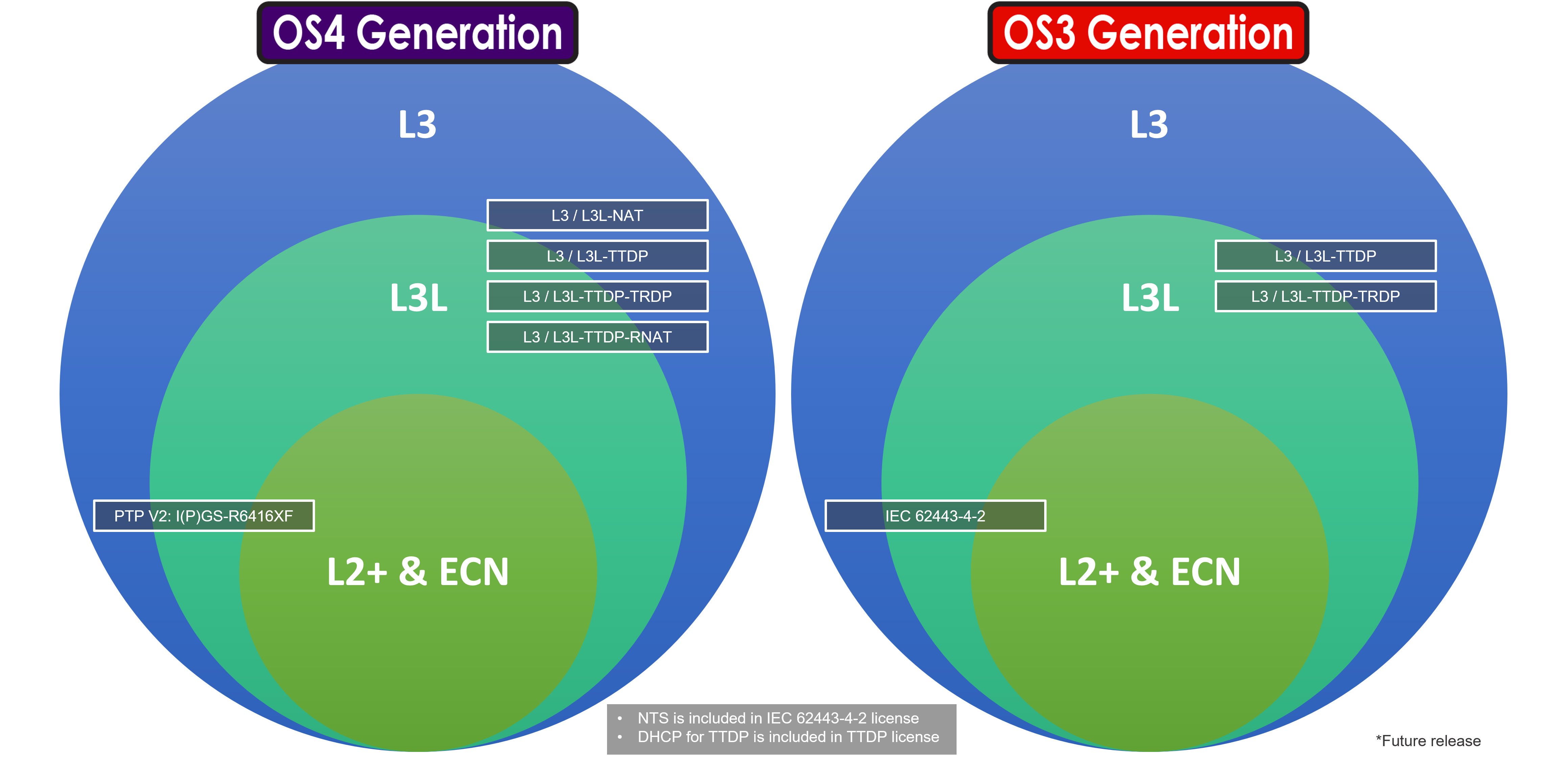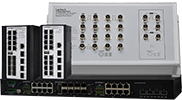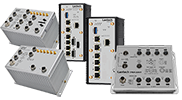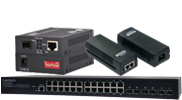Complete Layer 2 management switch with optional software package of IEC 62443, L3 Lite, L3, NAT and IEC 61375-2-5 ETBN
![]()
![]()
![]()
![]()
![]()
![]()
![]()
![]()
![]()
![]()
![]()
![]()
![]()
OVERVIEW
Lantech OS3/OS4 switch is powerful with complete Layer 2 management features and optional upgradable for future expansion, such as Layer 3 Lite, Layer 3, IEC61375-2-5 (ETBN), R-NAT (OS4), hardware NAT (OS4) etc.
Support Open API document for Restful API for better switch performance; Auto-provisioning for firmware/configuration update
The switch supports Restful API that uses JSON format to access and use data for GET, PUT, POST and DELETE types to avoid traditional SNMP management occupying CPU utilization. It also supports auto-provisioning for switch to auto-check the latest software image and configuration through TFTP server.
Auto feed configuration for swapped new switches for Seamless Network Maintenance
Lantech OS3/4 switch supports auto-feed configuration features that revolutionize network switch setup and management. It ensures that new and replacement switches automatically receive the correct configuration without manual intervention.
The Optional Certified Cybersecurity IEC 62443-4-2** Helps Maintain the Safety and Reliability of Critical Infrastructure and Ensures Operational Continuity
Lantech OS3 platform is designed with the optional IEC 62443-4-2 SL2 standard of cybersecurity to prevent threats from network attacks. It includes vulnerability checking, encrypted files, public key management, strong password enforcement, account management, and penetration and stress testing, totaling more than 90 security measures. The optional certified IEC 62443-4-2** defines component-level security requirements, meets a set of security requirements with FR.1 Identification and authentication control, FR.2 Use Control, FR.3 System Integrity, FR.4 Data confidentiality, FR.5 Restricted data flow, FR.6 Timely response to events, and FR.7 Resource availability, to effectively mitigate network threats at the hardware and software level.
DDoS Security to Protect Switch and Server
OS5 platform is designed with a high standard of security methods to prevent network threads, such as prevention of DDoS attacks, 802.1X security authentication, Dynamic ARP Inspection, IP Source Guard and Port Security. The MAC-based port authentication is an alternative approach to 802.1x for authenticating hosts connected to a port. By authenticating based on the host’s source MAC address, the host is not required to run a user for the 802.1x protocol. The RADIUS server that performs the authentication will inform the switch if this MAC can be registered in the MAC-table.
802.1X security by MAC address
MAC-based port authentication is an alternative approach to 802.1x for authenticating hosts connected to a port. By authenticating based on the host's source MAC address, the host is not required to run a user for the 802.1x protocol. The RADIUS server that performs the authentication will inform the switch if this MAC can be registered in the MAC address table of the switch.
DHCP option 82 & Port based, Mac based DHCP, Option 7/61/66, DHCP Snooping, IPv6 DHCP basic server
DHCP server can assign dedicated IP address by MAC or by port (Port based for single switch), it also can assign IP address by port for multiple switches with single DHCP option82 server. DHCP Snooping is supported. Support DHCP Option 61 allows DHCP servers to assign consistent IP addresses or apply specific policies based on the client identity. DHCP option66 server can offer IP address of TFTP server to DHCP client for VOIP application while DHCP option7 can offer IP address of logging server. Basic Ipv6 DHCP service can be supported. (DHCP option 61 is L3L or L3 license required)
User friendly GUI, Auto topology drawing
The user-friendly UI, innovative auto topology drawing and topology demo makes OS3/OS4 Ethernet switches much easier to get hands-on. The complete CLI enables professional engineer to configure setting by command line.
Enhanced G.8032 ring, 8 MSTI MSTP; MRP ring
Lantech OS3/OS4 Ethernet switches features enhanced G.8032 ring which can be self-healed in less than 20ms for single ring topology protection covering multicast packets. They support various ring topologies that covers enhanced ring and basic ring by easy setup than others. OS3 also supports standard G.8032 ring to install with the other vendor’s switch under G.8032 ring protection. OS3/OS4 support MSTP that allows RSTP over VLAN for redundant links with 8 MSTI. MRP (Media Redundancy Protocol) can be supported for industrial automation networks.
Enhanced Storm control
Storm control prevents traffic on a LAN from being disrupted by a broadcast, multicast, or unicast storm on one of the physical interfaces and the detection is more precise and reaction is more efficient.
Protocol based VLAN; Subnet based VLAN; QinQ, QoS and GVRP
It supports the QinQ, QoS and GVRP for large VLAN segmentation. The protocol-based VLAN processes traffic based on protocol. It filters IP traffic from nearby end-stations using a particular protocol such as IP, IPX, ARP or other Ethernet-types in a Hex value. Subnet based VLANs group traffics into logical VLANs based on the source IP address and IP subnet. The above features can help to build VLAN in the network mixed with managed and un-managed switch as to define packets to which VLAN group based on protocol or subnet.
IGMPv3, GMRP, router port, MLD Snooping, static multicast forwarding and multicast Ring protection
The unique multicast protection under enhanced G.8032 ring can offer immediate self-recovery instead of waiting for IGMP table timeout. It also supports IGMPv3, GMRP, router port, MLD snooping and static multicast forwarding binding by ports for video surveillance application.
Support NTP, SNTP server with built-in RTC clock source (RTC is subject to model variant)
The support of NTP/SNTP is able to synchronize system clock in Internet. Lantech OS3/OS4 switch supports NTP server & server/client mode. The switch also built-in a real-time clock (RTC) for measurement the passage of time with a NTP server. (RTC is subject to model variant)
Enhanced environmental monitoring for switch inside information
The enhanced environmental monitoring can detect switch overall temperature, total power load, actual input voltage and current. It can send the SNMP traps alert when abnormal. (Subject to model variant)
Snapshot switch information for trouble-shooting analysis
With the distinctive Snapshot feature to gather switch data including port statistics, system running information, configuration and event log at the point of time or by scheduling to address switch issues and analyze the root cause in a timely manner.
Optional Layer3 Lite / Layer3 to be upgradable
Lantech OS3/OS4 platform is optional upgradable to L3 Lite or L3 for future expansion. The optional L3L/L3 supports enhanced routing functionality, including RIP v1/v2(L3), OSPF v1/v2, DVMRP (L3), PIM, VRRPv2, VRRP aware PIM, hardware NAT, Static NAT, PAT, Port forwarding, etc. It provides better network performance for large scale applications. (NAT is only available on OS4-L3/L3L platform)
Optional TTDP, TRDP (MD Reply) and R-NAT protocol for train application (EN50155 models)
Lantech OS3/OS4 platform complies with IEC 61375-3-4 (ECN) standard. The support of Ethernet Consist Network allows interconnection between end devices located in single consist of train and interoperability with IEC61375-2-5 (ETBN). The optional TTDP (Train Topology Discovery Protocol) can assign IP and Gateway IP automatically when train network topology is changed due to the adjustment of train cars. Exclusive DHCP and VLAN over TTDP can help bind device with certain IP assignment and segment VLAN in ECN network. The optional R-NAT (Railway-Network Address Translation) is under TTDP that simplifies the management of network address translation between ETB and ECN. It supports TTDP** (Train Topology Discovery Protocol) according to IEC 61375-2-5, and TRDP** (Train Real-time Data Protocol) MD Reply.
Dual NTP Server Synchronization
The switch supports dual-source NTP synchronization to ensure continuous clock accuracy. By configuring Primary and Secondary NTP servers, the switch enables automated failover if the main source fails. This redundancy prevents clock drift, maintaining precise time-stamped logs across the network infrastructure.
10G Copper Cable Monitoring function
The 10G Copper Health Diagnostic tool proactively monitors 10G copper port SNR Margin data from chipset across all cable pairs to ensure optimal 10Gbps performance. Integrated into the Web UI , it enables administrators to proactively identify signal degradation caused by electromagnetic interference, faulty connectors, or excessive cable runs that may trigger automatic speed reductions , provide the rapid troubleshooting and ensuring optimal network reliability.
Optional LantechView** for Lantech devices maintenance
LantechView can automatically discover Lantech devices on the network, providing seamless configuration management. It supports both single-device operation and batch import/export of configurations across multiple IP subnets and VLAN areas, enhancing network efficiency and management.
Additionally, LantechView also features firmware management capabilities, allowing batch verification and simultaneous upgrades to the latest firmware versions, ensuring consistency across all devices.
To learn more about Lantech LantechView software solutions, please refer to Lantech LantechView Software Datasheet.
L2 SPECIFICATIONS
Manageability / Network |
|
Management |
SNMP v1 v2c, v3/ Web/ Telnet/ CLI |
User friendly UI |
|
SNMP MIB |
|
SNMP Trap |
Up to 5 trap stations; trap types including:
|
Firmware Update |
Supports TFTP firmware update, TFTP backup and restore; HTTP firmware upgrade; USB firmware update |
Configuration |
Supports editable configuration file for system quick installation; Support factory reset ping to restore all settings back to factory default |
DHCP |
Provide DHCP Client/ DHCP Server/DHCP Option 82/Port based DHCP; DHCP Snooping, DHCP Option 66; DHCP Option 7/66/PXE; basic IPv6 DHCP server; IPv6 port based DHCP |
Mac based DHCP Server |
Assign IP address by Mac in DHCP network |
DNS |
Provide DNS client feature and can set Primary and Secondary DNS server |
System Log |
Supports System log record and remote system log server |
PXE |
Offer IP address of TFTP server |
LLDP |
Supports LLDP to allow switch to advise its identification and capability on the LAN |
CDP |
Cisco Discovery Protocol for topology mapping |
Remote Admin |
Supports 25 IP addresses that have permission to access the switch management and to prevent unauthorized intruder |
Redundancy / Protection |
|
ITU G.8032 |
|
Spanning Tree |
Supports IEEE802.1d Spanning Tree and IEEE802.1w Rapid Spanning Tree, IEEE802.1s Multiple Spanning Tree 8 MSTI; Supports BPDU guard/Root guard/Aggregation port |
Protection |
|
PoE (PoE models) |
|
PoE Management |
PoE Detection to check if PD hangs then restart the PD |
Per Port PoE Status |
On/ Off, voltage, current, watts, temperature |
Security |
|
IEC62443-4-2 Cybersecurity ready**(OS3 only) |
|
Prevention of DDoS/DoS attack |
|
Network Security |
Support 10 IP addresses that have permission to access the switch management and to prevent unauthorized intruder. |
Login Security |
Supports IEEE802.1X authentication RADIUS/TACACS+ for Authentication |
Switching |
|
VLAN |
Port Based VLAN |
IGMP |
Support IGMP snooping v1, v2, v3; Supports IGMP static route; 1024 multicast groups; IGMP router port; IGMP query; GMRP |
MLD Snooping |
Support Ipv6 Multicast stream |
Static multicast forwarding |
Static multicast forwarding forward reversed IGMP flow with multicast packets binding with ports for IP surveillance application |
QoS |
|
Quality of Service |
The quality of service determined by port, Tag and Ipv4 Type of service, Ipv4 Differentiated Services Code Points – DSCP |
Class of Service |
Support IEEE802.1p class of service, per port provides 8 priority queues |
Bandwidth Control |
Support ingress packet filter and egress* packet limit. |
Port Trunk with LACP |
LACP Port Trunk: 8 Trunk groups |
Port |
|
Port Mirror |
Support 3 mirroring types: “RX, TX and Both packet” |
Enhanced Storm Control |
prevents traffic on a LAN from being disrupted by a broadcast, multicast, or unicast storm on one of the physical interfaces |
System |
|
Enhanced Environmental Monitoring |
System status for actual input voltage, current, total power load and ambient temperature to be shown in GUI and sent alerting if any abnormal status |
Dual Image Firmware |
Support dual image firmware function |
Time Management |
|
NTP/NTS |
Supports NTP/NTS to synchronize system clock in Internet |
PTP/gPTP** (OS4 only) |
IEEE 1588 PTP V2 & 802.1AS; Transparent clock and two step processing |
Diagnostic |
Support Ping, ARP table and DDM information |
Train Protocol (EN50155 models) |
|
ECN |
Complies with IEC 61375-3-4 (ECN) standard. |
Others |
|
Rescue mode |
Offer repairing ability to repair operating system if booting image of switch is damaged. |
*Future release
**Optional
***Annual license
Upgradable Package - L3 & L3Lite SPECIFICATIONS
Unicast Routing |
|
RIP v1/v2 |
Support RIP Redistribute
Support Enhanced Redistributing Routing Protocols
Support Equal-cost multi-path routing (ECMP) for RIP |
OSPF |
Support OSPF Area
Support Equal-cost multi-path routing (ECMP) |
Static Route |
Up to 32 |
Multicast Routing |
|
DVMRP |
Distance Vector Multicast Routing Protocol (DVMRP) is a routing protocol used to share information between routers to facilitate the transportation of IP multicast packets among networks. |
PIM (Protocol Independent Multicast) |
PIM-SM (Sparse Mode) |
Static |
Static multicast routing |
Routing |
|
VRRPv2(RFC3768) |
For Routing Redundancy Combine Max. 2 gateways as single virtual gateway VRRP aware PIM |
VLAN |
|
Inter-VLAN routing |
Support dynamic routing and static routing |
Router-on-a stick |
Route traffic between different VLAN groups via VLAN trunking port. |
NAT**(OS4-L3/L3L only) |
|
Hardware NAT |
Max 384 clients |
Static NAT |
Max 128 connections; 1 to 1 |
PAT (port address translation) |
Max 256 connections; 1 to many; many to 1; Port forwarding |
Train (EN50155 models) |
|
TTDP**/TRDP** |
TTDP (Train Topology Discovery Protocol) complies with IEC 61375-2-5 (ETBN) standard TRDP MD Reply. |
DHCP for TTDP** |
Support Option 61/82 |
R-NAT** (OS4-L3/L3L only) |
Support Railway-Network Address Translation |
Others |
|
IP based port |
Support |
*Future release
**Optional
ORDERING INFORMATION
| P/N | Model name | Description |
|---|---|---|
| 9000-114 | OS3 – L3L | OS3 software platform upgrade to Layer 3 Lite platform |
| 9000-115 | OS3 – L3L –RAIL | OS3 software platform with IEC-61375-2-5 ETBN (Ethernet Train Backbone Networks) function w/TTDP & TRDP MD reply (under L3L) |
| 9000-116 | OS3 – L3 | OS3 software platform with Layer 3 functions incl. L3L |
| 9000-117 | OS3 – L3 – RAIL | OS3 software platform with IEC-61375-2-5 ETBN (Ethernet Train Backbone Networks) function w/TTDP & TRDP MD reply (under L3) |
| 9000-11 | OS3 – IEC62443-4-2 | OS3 software platform IEC-62443-4-2 Cybersecurity features |
| 9000-110 | OS4 – L3L | OS4 software platform upgrade to Layer 3 Lite platform |
| 9000-113 | OS4 – L3L – RAIL | OS4 software platform with IEC-61375-2-5 ETBN (Ethernet Train Backbone Networks) function w/ R-NAT, TTDP & TRDP MD reply (under L3L) |
| 9000-112 | OS4 – L3 | OS4 software platform with Layer 3 functions incl. L3L |
| 9000-118 | OS4 – L3 –RAIL | OS4 software platform with IEC-61375-2-5 ETBN (Ethernet Train Backbone Networks) function w/ R-NAT, TTDP & TRDP MD reply (under L3) |








